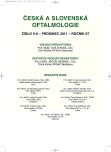Comparison of Keratometric Values and Corneal Eccentricity of Myopia, Hyperopia and Emmetropia
Authors:
P. Beneš 1; S. Synek 2; S. Petrová 2
Authors‘ workplace:
Katedra optometrie a ortoptiky – Pracoviště nelékařských oborů, LF MU
#2, #1Klinika nemocí očních a optometrie LF MU, Fakultní nemocnice u svaté Anny, Brno, přednosta doc. MUDr. Svatopluk Synek, CSc.
1
Published in:
Čes. a slov. Oftal., 67, 2011, No. 5-6, p. 181-186
Category:
Original Article
Overview
Purpose:
The aim of this work is to compare the findings of keratometric values and their differences at various ametropias. The eccentricity of the cornea in the sense compared to the possible influence of refraction of the eye is topographically observed. Groups of myopia, hyperopia and emmetropia are always represented 100 subjects, i.e. 600 eyes. The results of these measurements are mutually compared and statistically processed.
Methods:
The studied cohort a total of 300 clients enrolled. To measure the steepest (r1) and flattest meridian (r2) and to determine corneal eccentricity was used autorefraktokeratometer with Placido disc (KR 8100P, Topcon, Japan). The obtained data were processed with appropriate software and statistically evaluated.
Results:
Group A consisted of 100 myopes (n = 200), 35 men and 65 women, average age 37,3 ± 18,7 years (min. 10 years, max. 87 years). Objective refractive error - sphere: -2,9 ± 2,27 D (min.-0,25 D, -14,5 D max), cylinder: -0,88 ± 0,75 D (min. -0,25 D, up to -5,0 D).
Keratometry in this group is as follows:
radius of curvature of the cornea in the front area of the steepest meridian 7,62 ± 0,28 mm (min. 6,96 mm, max. 8,44 mm) and the flattest meridian is 7,76 ± 0,3 mm (min. 7,08 mm, max 8,75 mm). The mean eccentricity was 0,37 ± 0,12 (min 0,00, max. 0,79).
Group B consisting of 100 hyperopic subjects (n = 200), 40 men and 60 women, average age 61,6 ± 15 years (min. 21 years, max 88 years). Objective refraction in this group - sphere: +2,71 ± 1,6 D (at least +0,25 D, up to +9,0 D), cylinder: -1,0 ± 0,9 D (min. -0,25 D, max. -5,75 D).Corneal surface curvature in two main sections according keratometric measurement looks as follows: the steepest meridian is 7,67 ± 0,29 mm (min. 6,99 mm, max. 8,62 mm), the flattest meridian then 7,81 ± 0,29 mm (min. 7,10 mm, max. 8,70 mm). The value of the median eccentricity for these hundred hyperopes is 0,37 ± 0,14 (min. 0,00; max 0,86).
The third group C consists of 100 emetropic subjects (n = 200), then clients without refractive errors who achieve without corrective aids Vmin = 1,0. This group is composed of 42 men and 58 women, mean age 41,4 ± 17,8 years (min. 3 years, max. 82 years). Measured values of objective refraction - sphere: +0,32 ± 0,47 D (at least -1,75 D, up to +1,5 D), cylinder: -0,28 ± 0,45 D (min. -1,25 D, up to +1,25 D).Keratometry values measured at the corneal surface in two perpendicular cross-section are: steepest meridian corresponds to the radius of curvature of 7,72 ± 0,26 mm (min. 6,91 mm, max. 8,32 mm), the flattest meridian reaches values 7,83 ± 0,25 mm (min. 7,10 mm, max. 8,53 mm). The median eccentricity is represented by the observed values of 0,36 ± 0,11 ( min 0,00; max. 0,57). Due to the validity of the results from the groups as unsuitable respondents with corneal astigmatism greater than -1,0 D were subsequently eliminated.
Conclusion:
Keratometry as well as topography is one of the fundamental methods of measuring corneal front surface. Their proportions are essential for the proper parameters selection, especially with contact lenses as one of the possible means intended to correct refractive errors. The study subjects were not included in any load condition cornea, purulent conjunctivitis, blepharitis, after refractive surgery or other eye symptoms.
Key words:
corneal eccentricity, keratometry, corneal topography, refractive error
Sources
1. Mainstone, J.C., Garney, L.G., Anderson, C.R., Clem, P.M., Stephensen, A.L., Wilson, M.D.: Corneal shape in hyperopia. Clinical and Experimental Optometry. 1998, 81(3), pp.131–137. ISSN 0816–4622.
2. Efron, N.: Contact lens practice. Elsevier, 2010, 474 p., ISBN 978-0-7506-8869-7.
3. Rozsíval, P., Baráková, D., Cendelín, J. et al.: Trendy soudobé oftalmologie: Svazek 5. Praha: Galén, 2008, s. 183–199, 281 s. ISBN 97880726225345.
4. Najman, L.: Co je to asférická a atorická plocha. Česká oční optika. Praha: EXPO DATA, s.r.o., 2004, 45(2), s. 14, 52 s. ISSN 1211-233X.
5. Scholz, K., Messner, A., Eppig, T., Bruenner, H., Langenbucher, A.: Topography – based assessment of anterior corneal curvature and aspericity as a function of age, sex, and refractive status. J Cataract Refract Surg. 2009; 35(6): 1046–1054.
6. Szcotka-Flynn, L.: Ocular surface influences on corneal topography. Ocular Surface. 2004; 2(3): 188–200.
7. Nieto-Bona, A., Lorente-Velaquez, A., Montes-Mico, R.: Relationship between anterior corneal asphericity and refractive variables. Graefes Archive for Clinical and Experimental Ophthalmology. 2009, 247(6), pp. 815-820. ISSN 0721-832X.
8. Read, SA., Collins, MJ., Carney, LG., Franklin, RJ.: The topography of the central and peripheral cornea. Investigative Ophthalmology & Visual Science. 2006, 47(4), pp. 1404–1415. ISSN 0146-0404.
9. Petrová, S.: Tvrdé kontaktní čočky. Diplomová práce, UP Olomouc, 1992, 212 s.
10. Beneš, P. a Petrová, S.: Rohovková topografie v optometrii. Visionnews.eu. Ostrava: Printo, spol. s r. o., 2009(2): 15–17.
Labels
OphthalmologyArticle was published in
Czech and Slovak Ophthalmology

2011 Issue 5-6
Most read in this issue
- Comparison of Keratometric Values and Corneal Eccentricity of Myopia, Hyperopia and Emmetropia
- Minimal Ocular Findings in a Patient with Best Disease Caused by the c.653G>A Mutation in BEST1
- AquaLase Method – Influence to the Secondary Cataract Appearance and its Safety
- Suprachoroid Hemorrhage without the Connection to the Surgical Procedure
